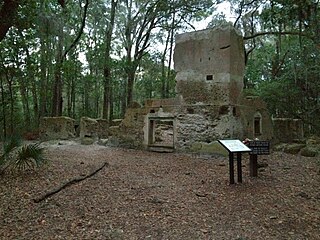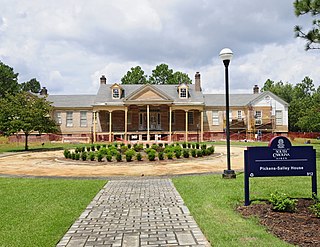
Edgefield County is a county located on the western border of the U.S. state of South Carolina. As of the 2010 census, its population was 26,985. As of the 2020 census, the population decreased to 25,657. Its county seat and largest municipality is Edgefield. The county was established on March 12, 1785.

Edgefield is a town in Edgefield County, South Carolina, United States. The population was 4,750 at the 2010 census. It is the county seat of Edgefield County.

Milledge Luke Bonham was an American politician and Congressman. He was later the 70th Governor of South Carolina from 1862 until 1864, and a Confederate General during the American Civil War.

Matthew Calbraith Butler was a Confederate soldier, an American military commander and attorney and politician from South Carolina. He served as a major general in the Confederate States Army during the American Civil War, postbellum three-term United States Senator, and a major general in the United States Army during the Spanish–American War.

Middleton Place is a plantation in Dorchester County, directly across the Ashley River from North Charleston and about 15 miles (24 km) northwest of Charleston, in the U.S. state of South Carolina. Built in several phases during the 18th and 19th centuries, the plantation was the primary residence of several generations of the Middleton family, many of whom played prominent roles in the colonial and antebellum history of South Carolina. The plantation, now a National Historic Landmark District, is used as a museum, and is home to the oldest landscaped gardens in the United States.

Hopsewee Plantation, also known as the Thomas Lynch, Jr., Birthplace or Hopsewee-on-the-Santee, is a plantation house built in 1735 near Georgetown, South Carolina. It was the birthplace of Thomas Lynch, Jr., a signer of the Declaration of Independence, and served as a Lowcountry rice plantation. Before he departed for his ill-fated voyage he made a will, which stipulated that heirs of his female relatives must change their surname to Lynch in order to inherit the family estate, a rice plantation. He was taken ill at the end of 1779 and he sailed, with his wife, for St. Eustatius in the West Indies. Their ship disappeared at sea in a storm and was never found. The family estate, Hopsewee, still stands in South Carolina. The Lynch family sold the house in 1752 to Robert Hume whose son, John Hume, lived at Hopsewee in the winter after inheriting it. Upon his death in 1841, his own son, John Hume Lucas, inherited the house. John Hume Lucas died in 1853. Like many Santee plantations, it was abandoned during the Civil War. After the war, rice was never planted again, but the Lucas family continued to occupy Hopsewee until 1925. In September 1949, Col. and Mrs. Wilkinson bought the house and occupied it.

Millford Plantation is a historic forced-labor farm and plantation house located on SC 261 west of Pinewood, South Carolina. It was sometimes called Manning's Folly, because of its remote location in the High Hills of Santee section of the state and its elaborate details. Designated as a National Historic Landmark, it is regarded as one of the finest examples of Greek Revival residential architecture in the United States. The house has been restored and preserved along with many of its original Duncan Phyfe furnishings.

The John Coleman House, also known as Grassdale, is a historic plantation house in Eutaw, Alabama, United States. The two-story wood-frame I-house was built by John Coleman from Edgefield, South Carolina, on property that he settled in 1819. Coleman held 75 slaves during the 1840 United States Census of Greene County. The house was placed on the National Register of Historic Places as part of the Antebellum Homes in Eutaw Thematic Resource on December 6, 1982, due to its architectural significance. Coleman family members, as well as many slaves, are buried in a cemetery close to the house. The house is currently used as a hunting lodge.

The Woodson Law Office is a structure within the Appomattox Court House National Historical Park. It was originally built by Samuel McDearmon in 1854 and rented by Woodson for his law office until he purchased it a couple of years later. It is a small structure and was built next to the main general store of Appomattox.

Millwood is the site and ruins of an antebellum plantation house at 6100 Garner's Ferry Road, Columbia, South Carolina. Owned by Colonel Wade Hampton II and his wife Ann Fitzsimmons Hampton, it was the boyhood home of their first son Wade Hampton III and other children. He later became a Confederate general and later, South Carolina governor, and U.S. Senator.
Darby Plantation may refer to:
Darby House or The Darby House or variations may refer to:

The Blocker House is a historic plantation house located near Edgefield, Edgefield County, South Carolina built circa 1790 by John Blocker, Sr. It is a two-story, clapboard dwelling with a one-story shed-roofed porch supported by four square columns. The property includes centuries old magnolia and cedar trees, a family cemetery, and several outbuildings.

Stoney-Baynard Plantation on Hilton Head Island, SC was listed on the National Register of Historic Places in 1994. The listing included one contributing site on 6 acres (2.4 ha).

The Pickens House, located in Aiken, South Carolina. It is reputed to have been built around 1829 by Governor Andrew Pickens for his son. In addition, the home is also noted for its early 19th century backcountry plantation architecture. Eventually the house was abandoned, and in 1929 it was moved from its original address near Edgefield to Aiken by a leading Aiken businesswoman and strong proponent of women's rights, Eulalie Chafee Salley. Around 1990 the home was again moved, this time to the campus of the University of South Carolina at Aiken. Much renovation work was taking place in the summer of 2012. The Pickens House was listed on the National Register of Historic Places on May 19, 1983.

Grove Plantation is a plantation house in Adams Run, South Carolina.

Botany Bay Plantation Wildlife Management Area is a state preserve on Edisto Island, South Carolina. Botany Bay Plantation was formed in the 1930s from the merger of the Colonial-era Sea Cloud Plantation and Bleak Hall Plantation. In 1977, it was bequeathed to the state as a wildlife preserve; it was opened to the public in 2008. The preserve includes a number of registered historic sites, including two listed in the National Register of Historic Places: a set of three surviving 1840s outbuildings from Bleak Hall Plantation, and the prehistoric Fig Island shell rings.

Farmfield Plantation House was built in 1854 for William Ravenel, a prominent Charleston businessman and banker. It is one of the few plantation houses with unaltered exteriors in St. Andrew's Parish which survived the American Civil War. The interior has been modified.

Cedar Grove is a historic plantation house located near Edgefield, Edgefield County, South Carolina. It was built between 1790 and 1805, and is a large two-story, Federal style house with a white clapboard exterior and high gable roof. It features a double-tiered portico with delicate Adamesque detail. This home has many unusual architectural features including a barrel-vaulted hallway, elaborately carved mantelpieces, and the right front parlor retains an early hand-painted French wallpaper.

Marshfield, also known as Old Marsh Home Place, is a historic plantation house located near Trenton, Edgefield County, South Carolina. The original house, built about 1831, rests on a foundation of brick and granite rocks. The house is an L-shaped, one-story frame residence with additions and alterations made in the late-19th and early-20th centuries. Also located on the property are the contributing early-19th century shed or "smokehouse"; an early 19th-century house, constructed of hand-hewn and pegged timbers and containing a stone fireplace; the Marsh family cemetery; and the archaeological remains of additional outbuildings.






















